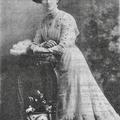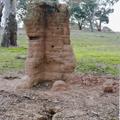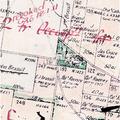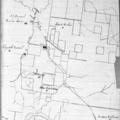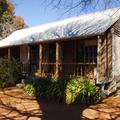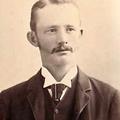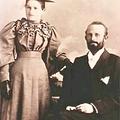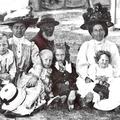< Early Canberra Government Schools
Warham [1893 - 1901]
Previous Name/s: Warroo
Warroo district and community
Warroo is a sheep and cattle grazing district about 16 km south of Yass, accessed via Wee Jasper Road. In the wake of Hume's explorations in the 1820s, stockmen, farmers and graziers began claiming the best lightly timbered country and grassy flats close to the Murrumbidgee River - Hume and other pioneers taking up vast tracks of land called stations, or runs, under permissive occupancy. By the 1840s, rough tracks from Yass to the sheep and cattle runs gradually became roads, one of which forded Warroo Creek and the Murrumbidgee River en route to the large 'squatter' owned stations of Cavan, Narrangullen and Wee Jasper.
As a bullock team hauling a loaded wagon travelled about 20 km a day, the creek crossing at Warroo became a convenient stage to water and rest the team overnight to or from Yass. Typically, an inn was opened at these rest stops to serve the bullock drivers and other passers-by. Warroo's was the 'Harp Inn', hosted in the 1870s by a Mrs Brassil. At about this time, the Yass Plains were becoming more closely settled by free selectors whose main concern was that their land claims should not have to compete with 'dummy' selections: that is, people installed by squatters to ensure that certain favoured areas, especially those with access to water, remained the squatter's land.
One Saturday evening in 1875, Harp Inn was the venue for the first meeting of the Yass Plains Freeholders' and Selectors' Association, called 'to discuss and adopt resolutions with regard to the land legislation the colony'. Opening the meeting, Mr Remmington announced that it had been called because 'a great many selectors residing in and about Warroo...(were) for retaining the residence clause as the best protection against dummyism' – to which hearty cheers resounded. Other issues included whether the cost of land (₤1 per acre) ought to be reduced, whether the size of a selection should be doubled to 640 acres (a square mile), and what the association's subscription should be (1/- a month adopted). Messrs Wilmot, Flanagan, Bolding, Duffy and Remmington were appointed to prepare a memorial for presentation to Parliament, and Mr Patrick Brassil made collector for the Warroo branch. (Trove: Australian Town and Country Journal, 20 March 1875)
The 1861 Land Act succeeded in 'unlocking' vast squatting runs to allow free selectors access to the land. A selector's life however, was never easy, especially in their first years of occupation. Under the Act 25% of the total land cost was to be paid on application, and the balance paid in 3 years without interest; or the balance could be extended indefinitely at a cost of 5% per annum. Residency was a requirement, so the selector had to erect a dwelling to live in, and also improve the property by ₤1 per acre within 3 years.
To achieve this, a selector had to clear and fence his land, maintain a small flock of sheep and perhaps some cattle, sow fodder crops, milk a cow or two, keep a kitchen garden, maintain farming equipment, and, in most cases, provide for a growing family. Not uncommonly, due to the Act's conditions not being met, a struggling selector forfeited his land back to the Crown, the selection then being available to another applicant.
It was this generation of free selectors raising families in the 1880s that made the first moves to obtain a public school at Warroo.
Early schooling at Warroo, 1893
Assisted by the Member for Yass Plains, Thomas Colls, an application for the establishment of a provisional school at Warroo was made by Elizabeth Brassil, EM Brassil, Henry Carey and John S Archer, on 18th January 1892. The school being sought was in Boambolo Parish, County Murray, about 10 miles from Yass on the road to Boambolo. The applicants undertook to enrol 20 pupils at the school. (For all Dept. of Educ. records quoted: 'Warham School', 5/18026.4, NSW Archives)
Yass district inspector Patrick F Sheehy visited the locality in April to report on the matter. The proposed site, he said, was 5 miles from Good Hope, 8 miles from Cavan and 7-8 miles from Boambolo (Kitty's bush). The expected enrolment of 15 would be insufficient for a provisional school, but adequate for a house-to-house teacher or half-time school. Accordingly, he recommended that a teacher be appointed 'provided that the residents at their own expense supply a building 17x14x10 feet, two WCs and the necessary school furniture'. He also thought their chosen school site 'too low lying' and proposed a better location on sketch maps appended to the report. (see below)
Submitted to a superior, Sheehy's report was amended to read that the parents be required to 'make up for any deficiency in the teacher's salary'; and further, that as a school called Warroo already existed, a different name would be needed - 'Warham' being chosen.
The next month Thomas Colls MP wrote a note to the Minister of Public Instruction inquiring if there had been a decision about the school. He had been informed that Mrs Brassil had offered a room for the school to occupy temporarily, and as the Warroo residents were 'feeling anxious about it', he wanted to know 'what action is likely to take place'.
The matter came to the fore when Cavan's teacher, Arthur Bundock, proposed an alternative to the planned closure of his school for want of pupils. As Cavan and Warroo had similar pupil numbers, he suggested to Inspector Sheehy that the two schools be operated half-time (ie sharing a teacher between them, as did many small bush schools). Penned on 24th July 1893, Bundock's letter read: -
... I interviewed several of the residents at Warroo who are anxious to establish a Half-time School at that place to be worked with Cavan.
Mrs Jno (John) Brassil has promised to provide a suitable room at Claremount – near Warroo, until the residents have sufficient time to erect a proper schoolroom.
I may further state that there are at least 15 children near Warroo whose parents are anxious that they should attend school.
Hoping you will be good enough to instruct me how to proceed in the matter.
Recognising advantages for both communities, Inspector Sheehy invited submissions from Warroo and Cavan. Duly given, Warroo's return nominated Patrick J Brassil RC, 'Hotelkeeper and grazier', as the school's correspondent, along with five other applicants: 'Andrew Bullman, EC, Farmer and Grazier; Elizabeth Brassil RC, Farmer and grazier; John Archer EC, Farmer; Henry Carey RC, Overseer, and John Sidebottom EC, Labourer. (EC is Church of England, RC, Roman Catholic).
In March 1893, Warham school was classified 'house-to-house' pending approval to operate jointly with Cavan. Inspector Sheehy then visited both localities and filed his report: There would be 14 pupils at Cavan and 16 at Warham. The former had a sawn-slab building in a reasonable state of repair, but at Warroo there was no school building as yet. However a site for Warham school had been selected by the Lands Department, resumed and notified on 31st July: namely Portion 251, Boambolo Parish, near the junction of Boambolo and Wee Jasper roads.
There were now new school representatives at Warroo: John Archer EC was the school correspondent, supported by William Coady RC, John Sidebottom EC, George Mitchell RC and Mrs Elizabeth Brassil RC. Sheehy recommended that John Archer be informed that the Department 'will appoint a teacher for Cavan and Warham to be worked conjointly as Half-time Schools at House-to-house rates, provided the residents will at their own expense erect a suitable building 17 x 14 x 9 feet and two WCs at Warroo on the 4-acre site ... and also provide necessary furniture'. A chief inspector, however, deleted 'Half-time' to clarify that Warham was classed 'House-to-house' until the residents built a school.
The parents at both localities requested that Arthur Bundock be recalled from Beggan Beggan, to which he'd been temporarily transferred until the Cavan-Warham arrangement was sorted out. A keen cricketer who was well liked at Cavan, Bundock would have been delighted when the Department acceded to this request.
Mrs Brassil's room was crowded with 16 pupils in these early months. Those enrolled were William Coady's children - Myrah 7, Adelaide 6 and Lecia 5 and William Harrigan 8; John Sidebottom's - Sarah 8, Hubert 6 and James 5; Elizabeth Brassil's - ME Brassil, FJ Brassil, TJ Brassil and GM Brassil; John Archer's - Milton 8 and Martha Harrigan 7; George Mitchell's - William 11, Lina 8 and Maggie 6.
A few months later, more space was obtained when the parents moved the school from Mrs Brassil's room to a cottage nearby. Classes continued here from October 1893 to April 1894, in barely adequate premises Inspector Sheehy described as follows: -
The cottage is detached and consists of two rooms with a temporary partition between. Its dimensions are 21 x 11½ x 6 feet. It has three windows, a chimney, a calico ceiling and an earthen floor. The furniture consists of a table 7½ x 3 feet, one form which is a fixture, and a few shelves for books.
Sheehy recommended John Archer be informed that providing the parents 'do the place up generally' and provide additional forms, it would be approved for school purposes; though it might be necessary for them to supplement the teacher's salary. The work duly completed and inspected, classes commenced in the cottage on 25th October 1893.
The first teacher, Arthur Bundock
For six months Arthur Bundock taught in this rustic cottage. He would arrive on horseback, conduct school, reside 3 or 4 nights at Elizabeth Brassil's, then return to Cavan and teach a half-week there. He also formed a romantic attachment with Ethel Archer, elder daughter of John Archer, Warham school's parent representative.
Over the same period, a working team put all their spare time into building a proper school on the government's notified site. Given their limited income they built a solid school; its pise rammed-earth walls providing good insulation in summer, and with a fire going, warm in winter. It had a hardwood floor and round timber rafters and joists. Inspector Sheehy described it to the Department as follows: -
The building, which is on a 4 ac vested site, was erected in 1894 by the residents. Its dimensions are 17 x 14 x 9 feet. The walls are of pise work and are very rough, not being plastered or cemented. The ceiling is of calico and the roof is covered with iron.
There are two out-offices with slab walls and bark roofs.
There was a severe drought while the school was being built, and when their crops failed, the parents informed the Department that having been reduced 'to almost a state of government assistance', they could not afford the classroom furniture: they were in need, they said, of 4 desks about 7ft long, 4 matching forms, a book press, table and chair. Inspector Sheehy acceded to their request, recommending that the furniture be forwarded free of cost to Yass railway station. In June 1894 the new schoolroom was inspected and approved for use.
Shortly before the school opened, Arthur Bundock and Ethel Archer were married at Warroo (Arthur, 30 and Ethel, 21). However, when their child was born in December that year, there was some gossip about Alice's pre-marriage pregnancy. Just two weeks after the birth, a Warroo resident named Thomas Howall wrote directly to the Department's under secretary requesting that Arthur Bundock be moved to some distant school for the moral good of the community. The letter read as follows: -
'I send you the undermentioned facts which speak for themselves to show you the sort of teacher we have to teach his pupils the principles of morality. Married at Warroo 24th June 1894, Arthur Bundock to Atty Archer. Birth at Royal Hotel Yass 13th Dec'r 94, Mrs Bundock of a son not six months.
In sending this I do not wish him any harm but as ther (sic) are a deal of talk about it, I think it would be wise to remove him to some place whare (sic) the facts are not knowing as I think the School will not be supported now – perhaps I ought to have sent this to the district Inspector but I think he must know and I thought it best to send it to you.'
Required to inquire about the matter, Inspector Sheehy began by asking Bundock (not mentioning the letter) who the man was and whether he had pupils at either school. When Bundock replied that Howall was a Waroo farmer whose children had been privately taught, Sheehy recommended that the matter be dealt with as follows: -
'Mr Howell has no children attending Cavan and Warham H to H school. His children have always been taught privately. It would appear therefore, that his motive for suggesting the removal of the Teacher is not solicitude for the welfare of the school. I have received no complaint about Mr Bundock from any other resident. The question of removing him should, I think, be deferred till after the next inspection of his school. I recommend that Mr Howall be informed accordingly.' (Memo, 4 Feb. 1895, 'Cavan School', 5/15343.1, NSW Archives)
Although the under secretary concurred, the Minister for Public Instruction thought otherwise: Bundock was summarily removed to Chain of Ponds public school (near Gunning) on 28th February 1895. Both at Cavan and the many other schools he later served at, Arthur Bundock was a popular, well-respected teacher. A skilled sportsman himself, he enthusiastically encouraged all sports wherever he taught. In 1913 he contracted hydatids when he was 48. He had successful surgery for it, but died not long after the operation from a weak heart.
A fully owned government school, 1896
Yass-born teacher William Faulder replaced Bundock temporarily for 3 months in 1895, followed by Albert Alchin who served from May to December that year. Thereafter all teachers at Warham were female, as its conversion to full-time no longer required male teachers riding half-weekly to another school.
First to arrive was Miss Alice Pettingell, 23, who was transferred from Berebangalo provisional school. Inspector Sheehy approved her travel costs: 'Train to Yass Township 37 shillings and 9d, thence conveyance about 10½ miles 10 shillings, total 47 shillings and 9d'. Board was arranged at Mrs J Brassil's residence, a comfortable walk of ¾ mile to the school. Like her two predecessors, however, Miss Pettingell served only a few months at the school, being replaced mid-year by Miss Amy Rouse, who served for a year before she resigned in May 1897.
Pupil enrolments increased during these first few years. When it opened in 1894, the school was converted from 'house-to-house' to 'half-time' - paying a slightly higher teacher's salary. Then in January 1896, the school numbers having increased, it was raised to a provisional school with classes five days a week. It now became a moot point whether the parents should continue paying for repairs and improvements to the school, or if this was the Department's responsibility.
The need to reach a decision came to a head when John Archer sought a contribution from the Department for the parents' total outlay on the school. Archer had been widowed when his wife Mary died in March 1894, and began putting the school's affairs in order before he moved out of the district. He placed his youngest child, 9-year-old Milton, in the care of his daughter Ethel and her husband Arthur Bundock, and handed the school's financial records to his grown-up son, Walter, a local free selector. Walter then continued corresponding with the Department on the matter.
It was raised with Inspector Sheehy that, in assuming increased responsibility for a school on government property, the Department was bound to compensate its owner-builders. Before this was settled, however, Archer left the district for the Snowy highlands, leaving unpaid debts on some building materials and repairs made to the school. The eventual outcome was that the Department paid off all outstanding debts on the building in order to fully acquire the school. Inspector Sheehy's report –endorsed by the Department – recounts the situation and its outcome as follows: -
The school is on a 4 ac vested site. ... Mr John Archer is, I have been informed, responsible for the expense incurred in connection with its erection. He has, however, left the district. His present address is Coolamon. The debt for the materials is 12 pounds 8/6, the creditors being Mr McCoen and Messrs Thompson and Bales of Yass. ...The debt and tender for the repairs required, amount to 16 pounds. ... I advise that Mr John Archer be informed that the Department is prepared to take over the building ... on condition that he will furnish a document signed by all the residents concerned stating that they are satisfied with this arrangement. (Inspector Sheehy, Yass, memo to a deputy chief inspector, Sydney, 10 October 1896)
The school's later years
Once the Department had taken over the school, various improvements were made to the building, beginning with guttering and a 400-gallon water tank. Previously, the pupils had brought their own water from home, supplemented by buckets filled at nearby Doctor's creek; so the tank was a welcome addition.
Other work included lining the ceiling with 6" x ¾" colonial pine boards; refixing the slab gables to close up openings between them; reboarding the chimney breast; lining the back of the chimney with stone; fixing locks on the windows; renewing board floors in the out-offices (toilets); filling cracks and holes in the pise walls, and whitewashing all walls internally and externally with 'two coats of the best whitewash'. Specified by Inspector Sheehy in mid 1897, the work was done by a Yass builder, Mr John Newman.
Alice Edwards was appointed to the school in July that year, in place of Amy Rouse who had left the service two months earlier to marry Alfred Thatcher in Wagga. Sheehy had some difficulty replacing Miss Edwards in mid-year, and after the school had been closed for several weeks he received an inquiry from Elizabeth Brassil asking how long it would be before they had a teacher. The closure, though, was a good opportunity to carry out the renovations.
Shortly after she arrived, Miss Edwards formally applied for a clock and a book press. Sheehy considered the press a reasonable request and recommended that the 'Clerk of Works be instructed to forward one to Yass Township tram station, addressed to the Teacher, Miss Alice Edwards'. A chief inspector at Sydney noted 'I concur', adding that Miss Edwards 'be authorised to purchase clock at cost not exceeding 7/6'.
Contagious epidemics would occasionally sweep through a school, often infecting the teacher as well. On 12th December 1898, Miss Edwards wrote to Inspector Sheehy about one such epidemic: -
Sir, I have the honor (sic) to inform you that only two pupils attended school on Monday 5th December and none on Tuesday Wednesday Thursday and Friday.
They were laid up with measles and influenza and only two were able to attend before today.
I therefore beg permission to omit these when calculating the daily average attendance for the quarter.
In February the next year Miss Edwards was transferred to Harefield school and replaced at Warham by Mrs Emily Clark. Measles had also swept through the school Mrs Clark last served at, as she had taken two weeks sick leave for it in November 1898. About a month after the sickness she became pregnant, so was dangerously close to having her unborn child being affected by the disease.
She gave birth to a baby daughter in Yass on 1st October 1899, assisted by Dr PJ Thane who wrote a medical certificate to assist her application for leave, advising the Department she should not resume duties for a month. Accordingly she wrote to Inspector Sheehy: 'I have the honour most respectfully to apply for a Month's Leave of Absence on account of my accouchement which took place on the 2nd October. I enclose Dr Thane's certificate'. Sheehy asked her to list any other leave taken in the previous 12 months, and when she replied that her only leave had been the two weeks for measles, a month's accouchement leave was granted.
Mrs Clark was an efficient, capable teacher who saw that the classroom was well maintained. In January 1900, she reported that the walls had been limed, a window repaired and blinds fitted; the work being completed as tendered: 'Lime etc 7/-, Glass 6d, Blinds 1/-, Labour 1 guinea - total ₤1/14/6.
Two months later further approval was given for major work to the outside toilets, at the cost of ₤1/5/6 : 'To supply bark and re-roof both out-houses putting new gable ends where needed. To remove slabs of walls and guards of outhouses, and replace them, putting them close together, supplying slabs enough to fill space caused by removal'.
Unusually for such a tender, this job description was pre-typed for Emily Clark and a tradesman 'J.H. Kennedy Clark, Warroo' to sign; the reason being that it was sent to the school by Inspector Sheehy for Emily to return when the work was done. Most likely the workman was Emily's husband, James, and, for this reason especially, the inspector was making sure the document was correctly presented.
Mrs Emily Clark was the last teacher at Warham. Due to declining pupil numbers, it was reclassified back to a half-time school in July 1900, and closed permanently in December 1901. It is interesting that Emily taught half-weekly at Warham and Euralie schools over this period, since maintaining a horse to ride between schools was normally a male teacher's task. Evidently Emily was either a capable horsewoman, or being married, had a sulky. She was appointed to Wee Jasper provisional school in 1907 and served 10 years there, much respected as a teacher and resident.
In January 1906 a Warroo man named William Bullman informed the Department that passers-by were camping in the derelict school building, prompting correspondence as to its future. Bullman offered to buy just the roof for ₤4. However Inspector Sheehy recommended that this be declined, as 'To dispose of the roof only would reduce the building to a ruin, and render the rest of the materials worthless'. He estimated the whole building was worth about ₤10, and advised that it would be better to dispose of it intact.
Today one solid pise corner is all that remains of the parent-built school: slowly eroding from exposure to the weather. (see photo below)
(Contributed by Keith Amos, former teacher at The Mullion, out of Yass)
Location Map
Related Photos
Teachers
- Bundock, Mr Arthur J
10/1893 - 02/1895 - Faulder, Mr William Patrick
Half Time , 03/1895 - 05/1895 - Alchin, Mr Albert
Half Time, 05/1895 - 12/1895 - Pettingell, Alice
01/1896 - 05/1896 - Rouse, Amy
04/1896 - 05/1897 - Edwards, Alice Ann
07/1897 - 02/1899 - Clark (Lynch), Mrs Emily
02/1899 - 12/1901
NSW Government schools from 1848
- Warham (external link)
< Early Canberra Government Schools
If you are able to assist our work of identifying, documenting, and celebrating the early bush schools of the Canberra region, please contact us or .


